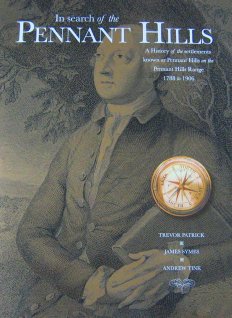In Search Of The Pennant Hills
|
|||||||||||||||
 The story behind the book
The story behind the book
In Search of the Pennant Hills
A History of the settlements
known as Pennant Hills on the
Pennant Hills Range
1788 to 1906
Why were there two thoroughfares in the early Sydney colony leading from Parramatta with very similar names, Pennant Street and Pennant Hills Road?
This seemingly innocuous question was for Jim Symes, who had been researching the history of the settlements along the Pennant Hills Range for over 30 years, a doorway into a secret untold history of Sydney's earliest days.
The quest to discover the meaning and purpose of Pennant Street, which linked all of the land grants Governor Arthur Phillip handed out during the formative years of the colony, expanded into an investigation not only of the origins of the colony but also the events leading up to and impact of the Castle Hill Rebellion - a larger political uprising than the Eureka Stockage.
But why the name Pennant?
New research by Jim Symes and his colleague Trevor Patrick has unveiled a surprising new theory. Contrary to the accepted wisdom that a flag or pennant was raised on those hills by soldiers to communicate with Government House at Sydney Cove, their research has located the man they believe the entire area was named after.
Why were a whole string of hills in the fledgling colony of Sydney named after Thomas Pennant, a man who never set foot in Australia?
Unravelling this question exposes a web of relationships between the power brokers of the early colony and their ties back to Mother England which despite the distance was always uppermost in the minds of the Governors of Sydney. With friends including Captain James Cook, Sir Joseph Banks and Francis Grose senior whose son Francis administered the Colony of New South Wales when Arthur Phillip returned to England in 1792, Thomas Pennant was a man with connections.
But who was Thomas Pennant?
Trevor Patrick, having researched and written a book on the reasons behind the street names of the Pennant Hills District, teamed up with Jim Symes in 1999 to research this and other questions. It took them eight years to finally bring the fruits of their research to the world, in a new book In Search Of The Pennant Hills which launches on Sunday 29th July at, appropriately, the main hall of the Pennant Hills Community Centre.
The period of history spanned by the book includes the development of modern-day suburbs from Ermington to Normanhurst and Epping to Castle Hill, and includes many biographies of notable citizens who influenced the district's formation.
Pioneer families of the area from Dundas, Carlingford and Pennant Hills have supplied many photographs and memories of the early days which have been included together with a chapter on Brush Farm and the early wine industry researched by Andrew Tink.
Jim and his wife Margaret travelled to Ireland and England on two occasions to research the details of the momentous events of the First Fleet voyage and the rebellion in Ireland of 1798. This work has been incorporated into the new book with a comprehensive appendix.
Jim and Trevor also spent many days in the Dixson and Mitchell library in Sydney, and Trevor travelled to Canberra to conduct original research using materials from the National Art Gallery and National University Library.
The manuscript has been skillfully edited by Deirdre Mowat, who graduated from the Linguistics Department of Macquarie University headed by Professor Pam Peters.
The team from Jenssen Design has fashioned an attractive coffee table book design from the various art sources, including the black and white pictures, some of which are over 100 years old, together with drawings made by John Hunter in 1788 and art commissioned to illustrate the Picturesque Atlas of Australasia in 1888. Colour pictures taken by Trevor and original maps tracing changes over time have been combined to produce a very beautiful book - much more than the usual history book, this is a work of art.